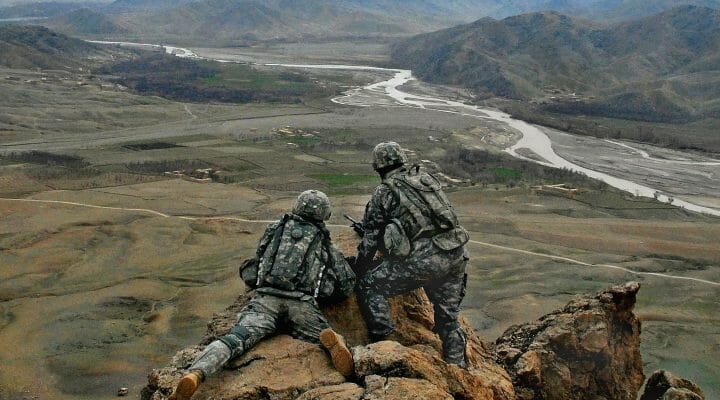Army officials released plans to cut 40,000 soldiers and 17,000 civilian employees by the end of fiscal year 2018 during a Pentagon press conference July 9. Details of the planned drawdown include which installations will suffer personnel cuts and the types of changes, like shrinking brigade combat teams, that are on the horizon. Here’s a breakdown of the current plan and how it will affect the overall force.
Soldier Changes
By the end of FY18, the Army’s fighting force should be 40,000 lighter and sitting at a total of 450,000 soldiers. The cuts will be gradual with a loss of 15,000 soldiers in both FY16 and FY17 and the final 10,000 in FY18. The Army isn’t focusing on losing any particular specialty, rather the cuts will range across the board from infantry soldiers all the way to military police and trainees. It’s hoped that many of the cuts will come from early retirement, resignations and adjustments in recruiting. However, some soldiers will likely be involuntarily forced out. Added to the previous cuts of 80,000, these changes will bring a total loss of 120,000 soldiers, or 21 percent of the force, since 2012.
Installation & Unit Changes
While many installations will be affected by personnel cuts, six installations will bear the brunt of the personnel reductions with the loss of more than 1,200 soldiers each. Here’s a quick look at the installations and how many soldiers they stand to lose.
- Fort Benning, Georgia: 3,402 soldiers (29 percent)
- Joint Base Elmendorf-Richardson, Alaska: 2,631 soldiers (59 percent)
- Fort Hood, Texas: 3,350 soldiers (9 percent)
- Fort Bliss, Texas: 1,219 soldiers (5 percent)
- Joint Base Lewis-McChord, Washington: 1,251 soldiers (5 percent)
- Schofield Barracks, Hawaii: 1,214 soldiers (8 percent)
The Army will continue its ongoing plan to reduce the number of brigade combat teams from 45 to 30 by the end of FY17. In some cases, the 4,000-person brigade combat teams will be converted into 1,050-person brigade task forces.
For example, the 3rd Brigade Combat Team, 3rd Infantry Division at Fort Benning and the 4th Infantry Brigade Combat Team (Airborne), 25th Infantry Division at JBER, Alaska, will both convert to maneuver battalion task forces by FY17.
At Schofield Barracks in Hawaii, the 2nd Brigade Combat Team, 25th Infantry Division will convert from a Stryker BCT to a two-manuever-batallion infantry brigade combat team. It’s possible the Stryker equipment will be absorbed by the 81st Brigade Combat Team, a National Guard unit headquartered in Washington State.
Two major unit relocations involve the the 3rd Expeditionary Sustainment Command moving from Fort Knox, Kentucky, to Fort Bragg, North Carolina, and the 1st Theater Sustainment Command moving from Fort Bragg to Fort Knox. Neither move will require new construction and should be completed in the next year.
Additionally, the plan includes the reduction of two-star and higher Army headquarters by 25 percent. For divisions, this means a loss of about 225 soldiers. For corps-sized headquarters, a loss of about 222 soldiers.
Civilian Changes
The Army plans to reduce the civilian workforce by 17,000 during FY16 and FY17. Army officials believe the reductions can be achieved through attrition and by keeping open positions unfilled. The Army previously cut the civilian workforce by 8,000, which means a potential total loss of 25,000 civilian employees by the end of FY17. More information about civilian cuts should be released in the next 60-90 days.
The Future
If the changes go through without any issues, the Army has the potential to save $7 billion over four years. It should be noted, however, that if sequestration continues, the Army will have to reduce its force even further to 420,000 starting in 2019. Should this occur, Director of Force Management for the Army Brig. Gen. Randy George says it would pose a significant risk for Army operations.
“The resulting force would be incapable of simultaneously meeting current deployment requirements and responding to the overseas contingency requirements of the combatant commanders,” he said.
What Leaders Are Saying
Several key leaders are speaking out about the upcoming cuts and changes. Here are some of the more notable quotes at a glance.
“These are incredibly difficult choices,” said Brig. Gen. Randy George. “The Army followed a long and deliberate process that included utilization of a [Government Accountability Office]-endorsed military value analysis process, and an inclusive total Army analysis, in order to determine the best construct for the Army, based on the threats we face and the current fiscal environment we must operate in.”
“With global instability only increasing, and with just 33 percent of the Army’s brigade combat teams ready for deployment and decisive operations, there is simply no strategic basis to cut Army force structure below the pre-9/11 level of 490,000,” said Sen. John McCain, R-Ariz, chairman of the Senate Armed Services Committee.
“These are not cuts the Army wants to make, these are cuts required by the budget environment in which we operate,” said Gen. Daniel Allyn, vice chief of staff of the Army. “This 40,000-soldier cut … will only get us to the program force, it does not deal with the continued threat of sequestration.”
“There is no doubt that communities will suffer under these reductions,” said retired Lt. Gen. Guy Swan, vice president of education for the Association of the United States Army, in a statement. “Beyond the local economic impact, AUSA is on record as stating that an active component force of less than 490,000 presents unacceptable risks to America’s ability to protect our interests worldwide.”
“People who believe the world is safer, that we can do with less defense spending and 40,000 fewer soldiers, will take this as good news. I am not one of those people,” Rep. Mac Thornberry, R-Texas, chairman of the House Armed Services Committee, said in a statement.




